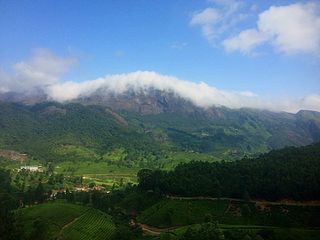
The Western Ghats or the Western Mountain range is a mountain range that covers an area of 160,000 km2 (62,000 sq mi) in a stretch of 1,600 km (990 mi) parallel to the western coast of the Indian peninsula, traversing the states of Gujarat, Maharashtra, Goa, Karnataka, Kerala and Tamil Nadu. It is a UNESCO World Heritage Site and is one of the 36 biodiversity hotspots in the world. It is sometimes called the Great Escarpment of India. It contains a very large proportion of the country's flora and fauna, many of which are endemic to this region. According to UNESCO, the Western Ghats are older than the Himalayas. They influence Indian monsoon weather patterns by intercepting the rain-laden monsoon winds that sweep in from the south-west during late summer. The range runs north to south along the western edge of the Deccan Plateau and separates the plateau from a narrow coastal plain called Konkan along the Arabian Sea. A total of 39 areas in the Western Ghats, including national parks, wildlife sanctuaries and reserve forests, were designated as world heritage sites in 2012 – twenty in Kerala, ten in Karnataka, six in Tamil Nadu and four in Maharashtra.

Savitribai Phule Pune University (SPPU), formerly the University of Poona, is a collegiate public state university located in the city of Pune, India. It was established in 1949, and is spread over a 411 acres (1.66 km2) campus in the neighbourhood of Ganeshkhind. The university houses 46 academic departments. It has about 307 recognized research institutes and 612 affiliated colleges offering graduate and under-graduate courses. Savitribai Phule Pune University Ranked 12th NIRF Ranking in 2022

Mulshi is the name of a major dam on the Mula river in India. It is located in the Mulshi taluka administrative division of the Pune district of Maharashtra State.

Karikaanamma or Shri Karikaan Parameshwari is a Hindu goddess temple in the Western Ghats in Karnataka, India, located near the town of Honnavar, established by Shreedhar Swami. Garbhagudi is carved out of a single rock. In 1970s when Indira Gandhi visited the temple, roads were fully built up to uphill. It is located in the very dense forest, so it is favorite spot for nature lovers. There are views of the Arabian sea from the top of the mountain. It is dedicated to the deity Kali . Ondadke or Vandadake Shambhulingehwara temple is also nearby to this place.

Ramachandra "Ram" Guha is an Indian historian, environmentalist, writer and public intellectual whose research interests include social, political, contemporary, environmental and cricket history, and the field of economics. He is an important authority on the history of modern India.
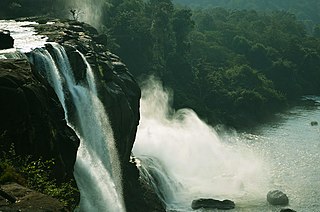
Athirappilly is a first grade Grama Panchayath with 489.00 km2 area in Chalakudy Taluk, Thrissur district in Kerala, India. It is located 60 km from Thrissur city, 70 km northeast of Kochi city, 55 km northeast of Cochin International Airport, and 30 km from Chalakudy town.

Athirapilly Falls, is situated in Athirapilly Panchayat in Chalakudy Taluk of Thrissur District in Kerala, India on the Chalakudy River, which originates from the upper reaches of the Western Ghats at the entrance to the Sholayar ranges. It is the largest waterfall in Kerala, which stands tall at 81.5 feet. Just a short drive from Athirapilly to the Vazhachal falls, which is close to dense green forests that are home to many endangered and endemic species of flora and fauna.

Sacred groves of India are forest fragments of varying sizes, which are communally protected, and which usually have a significant religious connotation for the protecting community. Hunting and logging are usually strictly prohibited within these patches. Other forms of forest usage like honey collection and deadwood collection are sometimes allowed on a sustainable basis. NGOs work with local villagers to protect such groves. Traditionally, and in some cases even today, members of the community take turns to protect the grove. The introduction of the protected area category community reserves under the Wild Life (Protection) Amendment Act, 2002 has introduced legislation for providing government protection to community held lands, which could include sacred groves.
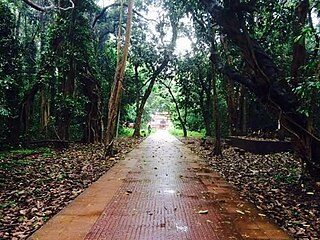
Kāvû is the traditional name given for sacred groves across the Malabar Coast in Kerala, South India. Kavus are notable for Theyyam, the centuries-old ritual dance.

The state of Maharashtra in India has several major river systems including those of the Narmada, Tapti, Godavari and Krishna rivers. The ecology of these rivers and associated wetlands is covered in this article.

Dhananjay Ramchandra Gadgil, also known as D. R. Gadgil, was an Indian economist, institution builder and the vice-chairman of the Planning Commission of India. He was the founder Director of the Gokhale Institute of Politics and Economics, Pune and the author of the Gadgil formula, which served as the base for the allocation of central assistance to states during the Fourth and Fifth Five Year Plans of India. He is credited with contributions towards the development of Farmers' Cooperative movement in Maharashtra. The Government of India recognised his services by issuing a commemorative postage stamp in his honour in 2008.
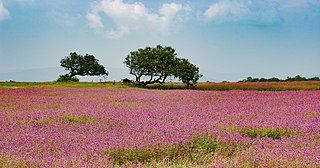
The Kas Plateau Reserved Forest, also known as the Kaas Pathar, is a plateau situated 25 kilometres west from Satara city in Maharashtra, India. It falls under the Sahyadri Sub Cluster of the Western Ghats, and it became a part of a UNESCO World Natural Heritage Site in 2012.
Sulochana Gadgil is an Indian meteorologist who retired as Professor from the Centre for Atmospheric and Oceanic Sciences (CAOS) in Bangalore, India. She has studied the how and why of monsoon, including farming strategies to cope with rainfall variability and modeling ecological and evolutionary phenomena. Her research led to the discovery of a basic feature of the sub-seasonal variation in the monsoon cloud bands. She demonstrated that the monsoon is not a gigantic land-sea breeze but instead is a manifestation of the seasonal migration of a planetary scale system which is seen over non-monsoonal regions as well. In collaboration with the farmers she derived farming strategies which are tailored to the rainfall variability of different regions in India.
Nirmal Ulhas Kulkarni is a herpetologist, field ecologist, conservationist, and wildlife photographer. Director (Ecology) of Wildernest Nature Resort, an eco-tel in the Chorla Ghats (Goa), Chairman of the Mhadei Research Centre, Team Lead of Hypnale Research Station and promoter of HERPACTIVE, a study initiative on Herpetofauna. As of December 2012, he lives in Goa.

The Western Ghats Ecology Expert Panel (WGEEP), also known as the Gadgil Commission after its chairman Madhav Gadgil, was an environmental research commission appointed by the Ministry of Environment and Forests of India. The commission submitted the report to the Government of India on 31 August 2011. The Expert Panel approached the project through a set of tasks, such as:
- Compilation of readily available information about Western Ghats
- Development of Geo-spatial database based on environmental sensitivity, and
- Consultation with Government bodies and Civil society groups.
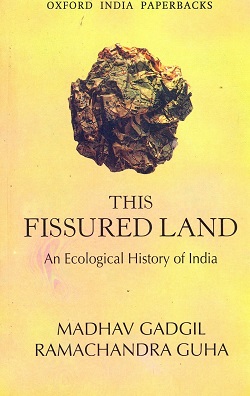
This Fissured Land: An Ecological History of India is a book by Madhav Gadgil and Ramachandra Guha on the ecological history of India. It examines 'prudent' (sustainable) and 'profligate' (unsustainable) use of natural resources, and their effects. It describes the ecological history of India, from the first humans, through the ages of hunter-gatherers, farmers, empires and the British Raj.
Gadgil is a Chitpavan brahmin surname from Maharashtra, India.

Vadayil Sankaran Vijayan is an Indian environmentalist, wildlife biologist, ornithologist, an admirer of naturopathy and the founding Director of the Salim Ali Centre for Ornithology and Natural History. He is currently the chairman of the Salim Ali Foundation.

Karachepone N. Ninan is an ecological economist. Dr. Ninan was born in Nairobi, Kenya where he had his early school education. Thereafter he relocated to India where he continued his high school and college education.



















